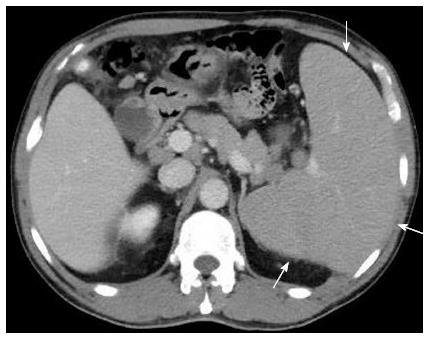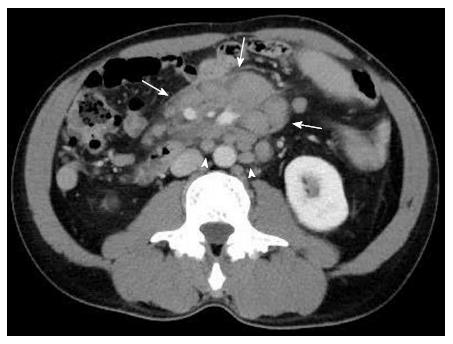Copyright
©The Author(s) 2015.
World J Gastroenterol. Dec 7, 2015; 21(45): 12981-12986
Published online Dec 7, 2015. doi: 10.3748/wjg.v21.i45.12981
Published online Dec 7, 2015. doi: 10.3748/wjg.v21.i45.12981
Figure 1 Contrast-enhanced axial computed tomography during the arterial phase showed one ill-defined mass with heterogeneous enhancement (arrows) and central necrosis (arrowhead) at segment 7.
Figure 2 Computed tomography later showed wash out during the delay phase; this is compatible with hepatocellular carcinoma (arrows) with chest wall involvement.
No obvious imaging evidence of liver cirrhosis and portal hypertension was shown.
Figure 3 Large homogenous enhanced spleen (arrows) is also noted in the upper abdomen; it is suggestive of splenomegaly.
Figure 4 Contrast-enhanced axial computed tomography showed a cluster of multiple enlarged lymph nodes in the mesenteric (arrows) and para-aortic regions (arrowheads).
Figure 5 Histological study of the liver tumor.
A: Neoplastic hepatocytes with pleomorphic nuclei and prominent nucleoli; they are considered diagnostic for hepatocellular carcinoma [Hematoxylin and eosin (HE) staining; original magnification × 400]; B: Tissue cores with thick trabeculae of neoplastic hepatocytes and a patchy lymphoid infiltrated (arrows) (HE staining; original magnification × 40); C: Small lymphoid cells with slightly irregular nuclei (HE staining; original magnification × 400).
Figure 6 Immunochemical analysis of the liver tumor.
A: The small lymphoid cells were positive for CD20 (CD20 immunostaining; original magnification × 400); B: The small lymphoid cells were positive for CD5 (CD5 immunostaining; original magnification × 400); C: The small lymphoid cells were positive for cyclin D1 (cyclin D1 immunostaining; original magnification × 400).
- Citation: Lee MH, Lin YC, Cheng HT, Chuang WY, Huang HC, Kao HW. Coexistence of hepatoma with mantle cell lymphoma in a hepatitis B carrier. World J Gastroenterol 2015; 21(45): 12981-12986
- URL: https://www.wjgnet.com/1007-9327/full/v21/i45/12981.htm
- DOI: https://dx.doi.org/10.3748/wjg.v21.i45.12981














